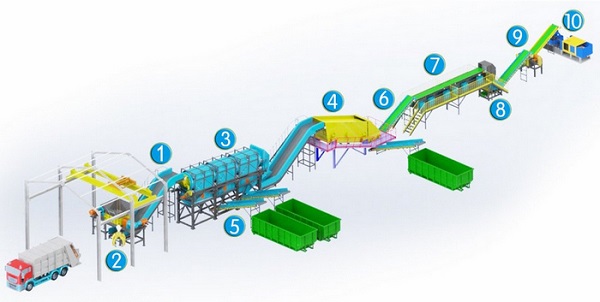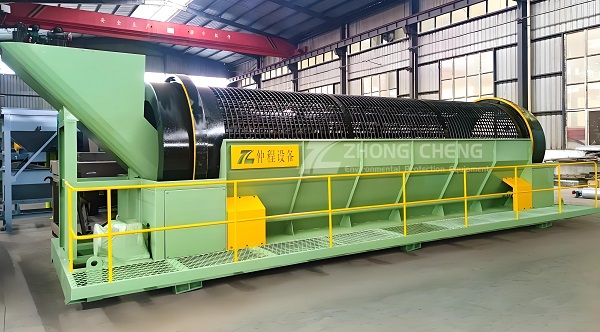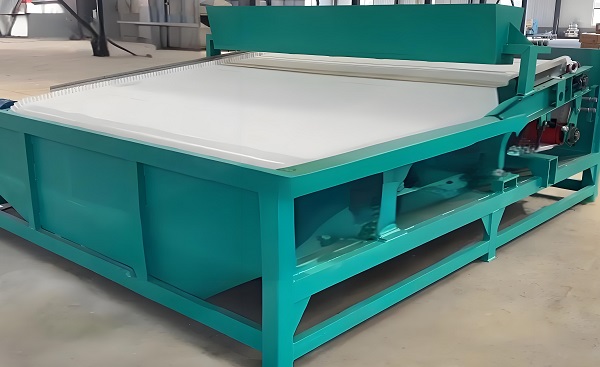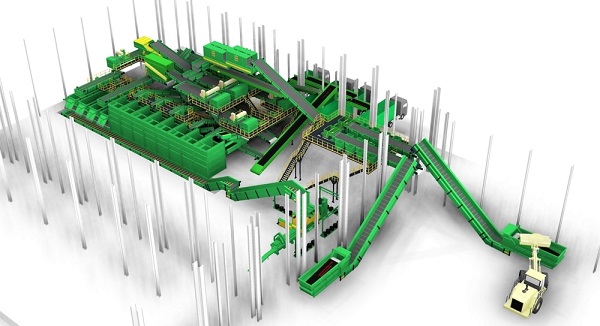Preface: As a key link in achieving waste reduction, resource utilization and harmless treatment, the importance of domestic waste sorting equipment is self-evident. This article will introduce in detail the working principle, classification, application and suggestions for selecting high-quality manufacturers of domestic waste sorting equipment, and contribute to the promotion of green life. Domestic waste sorting equipment is an important tool for achieving waste sorting. By effectively sorting garbage, the recycling rate of resources can be improved, the environmental pressure caused by landfill and incineration can be reduced, and the development of the circular economy can be promoted. In addition, it also helps to enhance the public's environmental awareness and guide people to form good habits of waste sorting.
A. The role of domestic waste sorting:
Domestic waste sorting equipment usually uses physical, chemical or biological methods to sort garbage. Physical methods include magnetic separation, wind separation, Trommel screening, etc., which are separated by the differences in the physical properties of different substances; chemical methods use chemical reactions to distinguish different components; biological methods use microorganisms to decompose organic matter. These technologies can be used alone or in combination to achieve the best sorting effect. Domestic waste sorting is an important part of modern waste management, and its role is reflected in many aspects:

Domestic waste sorting system
1. Resource recovery and utilization: Through sorting, recyclable materials (such as paper, plastic, metal, glass, etc.) in domestic waste can be separated. After processing, these materials can be re-entered into the production cycle, reducing dependence on original resources, reducing energy consumption and environmental impact. Resource recovery not only helps to save natural resources, but also creates economic value for enterprises and society.
2. Reduce landfill volume: Effective sorting can significantly reduce the amount of garbage that needs to be finally disposed of, especially when a large amount of organic waste is separated for composting or biogasification. This can not only extend the service life of existing landfills, but also reduce greenhouse gas emissions and other potential pollution problems caused by landfill.
3. Environmental protection: Unsorted domestic waste, if directly landfilled or incinerated, may cause serious environmental pollution, including soil, water and air pollution. For example, waste containing heavy metals or harmful chemicals can cause lasting ecological damage if it is treated indiscriminately. The sorting process can help identify and isolate such hazardous wastes to ensure that they are properly handled.
4. Improve economic benefits: With the rise in resource prices and technological advances, it is becoming increasingly attractive to extract valuable materials from garbage. An efficient sorting system can increase recycling rates, reduce processing costs, and bring new economic growth points to related industries.
5. Promote public environmental awareness: Promoting garbage classification and sorting measures and encouraging residents to participate in garbage management activities in daily life will help cultivate public environmental awareness and sense of responsibility. This change in social behavior is essential to achieving long-term sustainable development goals.
6. Comply with regulatory requirements: Many countries and regions have introduced strict garbage management regulations, stipulating that garbage must be collected and processed in a classified manner. Good sorting practices not only help companies and social organizations comply with laws and regulations, but also demonstrate an attitude of actively fulfilling social responsibilities.
7. Optimize the urban environment: Scientific and reasonable garbage sorting can effectively improve the sanitary conditions of the city, reduce problems such as mosquito breeding and odor emission, thereby improving the quality of life of citizens and the overall image of the city.
Domestic garbage sorting is not only a key step in solving the garbage problem, but also an important means to promote the circular economy, protect the environment, and promote the harmonious development of society. It has achieved the goals of reducing, recycling and harmless treatment of garbage through a series of technical measures, and has an irreplaceable role in building a green and low-carbon urban environment.
B. Classification and function of domestic waste sorting equipment
Domestic waste sorting equipment is a key tool for achieving effective classification and treatment of garbage. According to its working principle and technical characteristics, it can be divided into the following categories:
1. Screening equipment:

Trommel Screen
a. Trommel screen: By setting screens of different specifications inside the rotating cylinder, the garbage is initially separated according to the particle size.
b. Vibrating screen: The excitation force generated by the vibrating motor is used to make the material jump forward on the screen surface, and the material classification can be completed while dehydrating and removing mud.
c. Fixed screen: Use a fixed screen structure to perform simple and rough size screening of garbage.
2. Wind selection equipment:
Gravity separator: Use airflow to separate light and heavy materials such as paper, plastic film, etc. from soil, stones, etc. according to the density difference of the material.
3. Magnetic separation equipment:

Magnetic Separator
a. Permanent magnetic drum: Suitable for extracting ferromagnetic metals from mixed garbage, such as scrap steel products.
b. Electromagnetic sorting machine: It can generate stronger magnetic fields and is used for more complex or non-ferromagnetic metal recovery.
4. Photoelectric sorting equipment:
a. Optical sorting machine: Based on color recognition or near-infrared reflection characteristics, it automatically selects specific types of transparent or translucent items such as plastics and glass bottles.
b. Color sorting machine: It uses optical sensors to detect and separate objects of different colors. It is widely used in the food processing industry, but can also be used for garbage sorting.
5. Crushing equipment:
Jaw crusher, hammer crusher: It is used to crush large pieces of garbage into smaller sizes for subsequent screening and sorting.
6. Flotation equipment:
Flotation tank: According to the density difference of objects, it realizes the selective separation of solid waste in liquid medium, which is often used to recycle lightweight metals such as aluminum cans.

Domestic waste sorting production line
7. Comprehensive sorting system:
These systems usually integrate multiple equipment and technologies mentioned above to form a complete garbage sorting production line. They can be customized according to actual needs, integrating multiple links such as pretreatment, screening, and sorting to provide comprehensive solutions.
8. Manual sorting station:
In some cases, manual sorting is still a necessary supplementary means, especially when high-precision sorting is required or when facing complex and changeable garbage components. These stations are usually equipped with conveyor belts and other auxiliary tools to improve efficiency.
9. Intelligent sorting robots:
With the development of artificial intelligence and machine vision technology, more and more intelligent sorting robots are being used in the field of garbage sorting. These robots can quickly and accurately identify and grab specified types of garbage, greatly improving the speed and accuracy of sorting.
The selection of appropriate sorting equipment depends on factors such as the specific garbage composition, the expected sorting effect, and the economic cost. Modern garbage treatment facilities often combine multiple technologies and equipment to achieve the best resource recovery rate and environmental protection effect.
PS: Domestic garbage sorting equipment is an important support for achieving sustainable urban development. Choosing the right equipment and manufacturers can not only improve the efficiency of garbage treatment, but also promote the recycling of resources and contribute to the construction of a green home. Let us work together to create a cleaner and better living environment.
Save Time! Get A Detailed Quotation Quickly.
